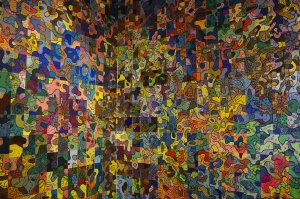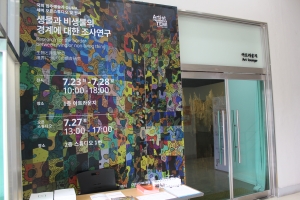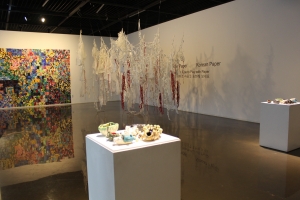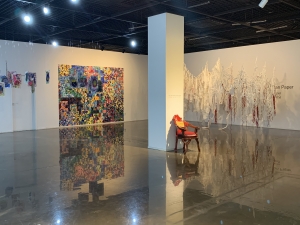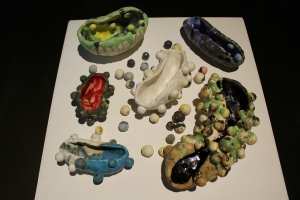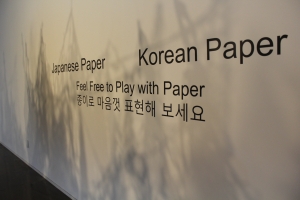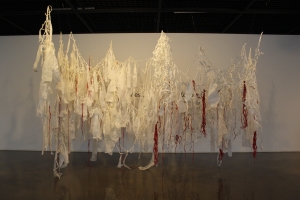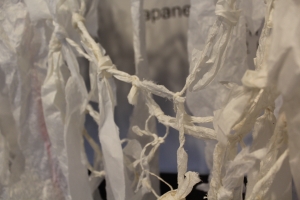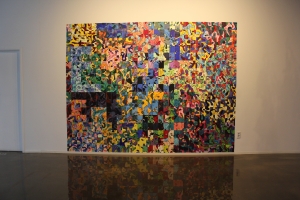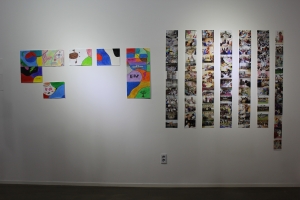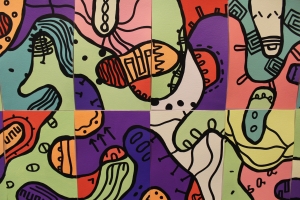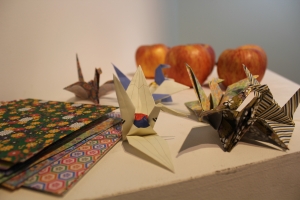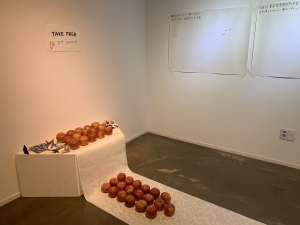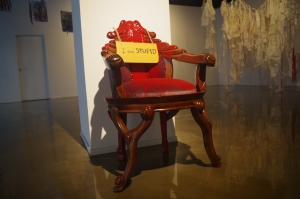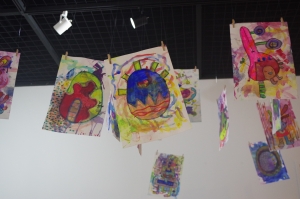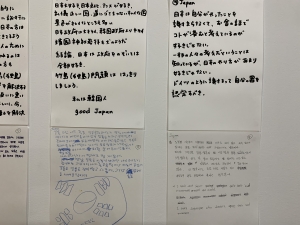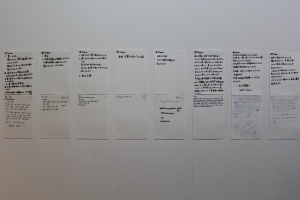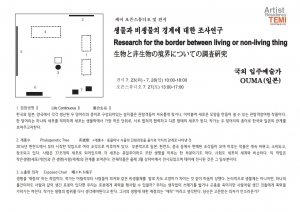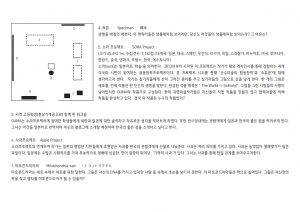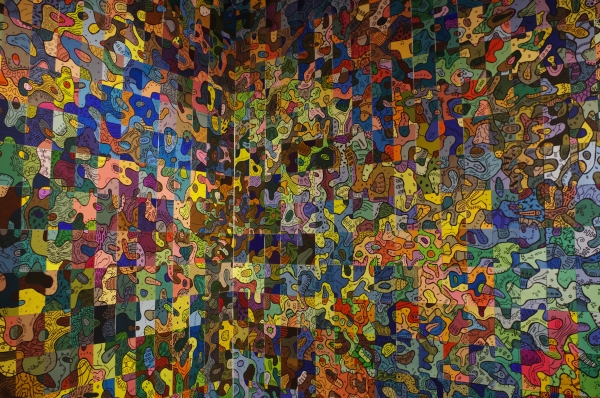전시 EXHIBITION
세미오픈스튜디오 및 전시Research for the border between Living or Non-living thing
생물과 비생물의 경계에 대한 조사연구
Research for the border between living or non-living thing
生物と非生物の境界についての調査?究
‘SORA 프로젝트’
작가가 현재까지 15개국의 지역민들과 함께한 프로젝트로 ‘공동창작의 예술품‘과’소유권‘에 대해 생각해 보고자 하는 작업이다. 작가는 자신의 스케치와 드로잉
이 그려진 A4지를 참가자들에게 나눠주고, 참가자들은 자유롭게 A4지를 채운다. 작가는 이를 이어 붙여 하나의 작품인 ‘The World ∞(infinity)’를 만들어 간다.
-
자연으로부터 배우는 공존의 기술
이선영(미술평론가)
2013년에 첫 개인전을 하면서 작가로 데뷔한 Ouma(Tomoko Omata)는 전직 수의사이다. 작가는 2011년에 동일본 지진의 여파로 무력감을 느껴 수의사를 그만두기 이전에도 자신의 환자인 동물들을 즐겨 그리곤 했다. 치료는 외과적인 차원뿐 아니라 내과적인 차원이 있기에 정상적 또는 비정상적 세포를 스케치하는 것도 포함된다. 이러한 자전적 배경은 생명과 생명의 기본단위인 세포 등이 떠올려지는 다양한 도상들로 나타난다. 수의학보다는 예술에서 더 자유로움을 찾은 그녀는 현재 세계 여러 나라를 돌면서 작업을 진행하고 있으며, 한국도 중간 기착지 정도쯤 된다. 테미 예술창작센터에서 국외 입주 예술가로 참여하면서 진행한 개인전 부제는 ‘생물과 비생물의 경계에 대한 조사연구’이다. 이 거창해 보이는 주제는 삶과 죽음 사이에서 정상과 비정상의 경계를 다루어왔던 이에게는 자연스럽다. 또한 경계의 문제는 과학에서 예술로 관심 분야를 변경시킨 자신에게도 중요한 문제였을 것이다.
전시장에 들어서자 보이는 세라믹 작품 [미토콘드리아씨 Mitochondria-san]는 세포에서 에너지를 만들어내는 중요한 기관인 미토콘드리아의 형태에서 영감을 받은 것으로, 고온으로 구워져 단단해지기 이전, 부드러운 흙을 주물럭거리면서 작가가 느꼈을 생명에 대한 이미지가 전달된다. 미토콘드리아는 원래 독립적 개체였지만, 다른 개체와 공생관계를 이루다가 내부기관이 된 경우다. 프리초프 카프라는 [생명의 그물]에서 공생기원설(symbiogenesis)을 소개한다. 이 이론은 항구적인 공생적 배열을 통해 새로운 생물형태가 창조되는 것을 모든 고등동물의 주된 진화 경로로 간주한다. 이 책에서 소개되는 생물학자 마굴리스에 의하면 미토콘드리아가 원래는 자유롭게 떠돌아다니던 박테리아였고, 아득한 과거에 다른 미생물 속으로 침입해 들어가 그 속에서 항구적인 자리를 차지하게 된 것으로 추측한다. 작가가 수많은 세포 내 기관 중에서 미토콘드리아를 주목한 것은 그것이 경계의 문제를 제기하기 때문이다.
나이면서 타자이기도 한 이 기관에서 중요한 점은 공생에 대한 메시지이다. 생물학 또한 오랫동안 세계관에 의해 좌지우지되었으며, 그러한 혐의는 가치 중립적인 과학의 시대에도 극복했다고 볼 수는 없다. 예술은 과학보다는 가치 지향적 인데, 작가는 경쟁이나 적자생존, 약육강식, 우세종 같은 유아독존식의 범주보다는 공존과 공생을 강조한다. 하나이면서 연결되는 작품들이 여러 형식으로 포진해 있다. 설치작품 [집합생명 Ⅱ Life Continuous Ⅱ]은 일본 종이와 한국 종이로 이루어진 것으로, 구별할 수 없을 만큼 얼기설기 연결되어 있다. 야생적으로 연출된 영역으로 관객 또한 들어갈 수 있고 걸려있는 종이들을 찢고 연결할 수 있다. 세포라는 미시적 우주 속으로 세포로 이루어진 개체가 들어가서 상호작용하는 것이다. 소우주는 대우주가 되고, 대우주는 다른 차원의 소우주가 될 수 있다. 생태학적 차원으로 확장하면 그것은 생명의 그물을 떠올린다.
프리초프 카프라는 [생명의 그물]에서 ‘인간들이 생명의 그물을 짜는 것이 아니다. 인간이란 단지 그 그물 속의 한 올일 뿐’이며, ‘ 그 그물에 가하는 모든 일은 스스로에게 향한 것’이라는 말을 인용한 바 있다. 물론 이러한 유기체적 사고는 기계의 약진을 통해서 변화해 나간다. 생물학자 출신의 사상가 다나 해러웨이는 [유인원, 사이보그, 그리고 여자]에서, 그리스인들은 시민(citizen), 도시(city), 우주(cosmos)가 같은 원리로 건설된다고 상상했다고 말한다. 그것은 개체가 살아 있는 거대한 우주적 유기체의 일부라는 사상을 낳았다. 그러나 이러한 사상은 기계와의 접속을 필수가 된 현대에 와서 확장될 필요가 생겼다. 오우마의 주제인 생물/비생물의 경계는 더욱 문제시될 것이다. 그것은 과학기술만큼이나 정치와 예술의 문제가 된다. 다나 해러웨이가 강조했듯이 무엇이 단위로, 즉 하나로 간주하는가의 문제는 영구적으로 주어진 것이 아니다. 열린 경계는 생명으로 친다면 질병이나 죽음을 떠올리는 것이다.
그러나 그것은 변화된 생태계에 적응하고, 더 나아가 새로운 종을 창발하는 실험이라고 할 수 있다. 작품 [집합 생명]에서 하나의 세포가 분열을 거듭하여 거대 유기체가 될 수 있듯이 찢고 연결하는 행위에는 생명의 과정을 압축한다. 또한 그것은 시간의 흐름을 타고 세분화 되고 낡아지는 과정을 보여준다. 생물에게 이러한 시간적인 과정은 필수이다. 연극무대의 세트와도 같은 설치작품은 시시각각 전개되는 과정과 그러한 과정을 주관 또는 향유하는 몸의 지각을 중시한다. 공간적 지각은 시간적 기억과도 연결된다. 일본의 화지와 한국의 한지는 얇기의 차이는 있지만 원재료는 같으며, 붉은 색종이는 시각적인 강조점을 준다. 간헐적으로 보이는 붉은 종이는 여러 세포들을 돌면서 영양을 공급하고 노폐물을 치우고 외부의 적에 대응하는 피를 연상시킨다. 오우마가 활용한 종이라는 소재는 나무라는 생명체로부터 만들어진 생산품이며, 서로 다른 국가의 종이를 사용한 것은 작가가 입주해 있던 시기에 불거진 한/일 관계 또한 반영되어 있다.
작가가 여기에서 강조하는 것은 분리보다는 엮임이다. 작품 [노출된 의자 Exposed Chair]는 늘 상 타자와의 협업을 염두에 두는 작가가 내어준 빈자리이다. 의자는 인간을 떠올린다. 보다 정확히는 부재의 자리지만, 부재를 통해 현존이 암시되는 것이다. 붉은색 물감을 뒤집어 쓴 이 의자는 ‘I am stupid’라는 지극히 인간적인 대사도 목에 걸고 있다. 작가는 생명의 정의를 ‘애착’으로 본다고 말한다. 대전에서 구입한 이 구식 의자는 작가에게 애착의 대상이라는 점에서 무생물에 머물지 않는다. 붉은색은 의자를 의인화함과 동시에 일본기 또한 떠올린다. 작품 [계통수 Phylogenetic Tree]는 가로가 20cm 되는 작은 종이에 그린 것들로 다른 색으로 칠해졌지만 선이 연결되어 있다. 낱장으로 판매되며 판매된 자리는 비워진 채 그대로 둔다. 따로, 또 같이 작동하는 이러한 스타일의 작업은 2016년 핀란드에서부터 시작되었으며 중국, 일본 등에서도 이어졌고 앞으로의 여정에도 함께 할 것이다.
여러 나라를 유목하는 작가에게 이러한 방식은 부분과 전체를 동시에 충족시켜주며 확장성을 가진다. 작가는 37조 개의 세포로 구성된 인체의 예를 들면서, 이러한 세포들이 모여 유일무이한 개인을 만들고 개인이 다시 사회를 이루고 있음을 강조한다. 작품이 선물이나 판매를 통해 사라져도 보충이 일어난다. 마치 이 순간에도 계속 갱신되고 있는 몸의 세포들처럼 말이다. 이러한 방식은 다른 이들과의 작업에도 관철된다. 세계 각국의 시민들이 참여하는 공동창작물인 소라 프로젝트(SORA Project)는 초현실주의에서의 이어 그리기 같은 방식으로 진행된다. 일본어로 ‘소라’는 하늘을 의미하므로, 이 작품들은 하늘을 이어 그리는 것이다. 국가는 영공, 영해 등의 개념으로 선이 없는 하늘과 바다에도 보이지 않는 선을 설정하곤 한다. 하지만 그것은 인간의 규칙일 뿐 자연의 법칙은 아니다. 한 작품이 하나의 세포, 또한 한 개인처럼 작동하는 공동창작은 한 작품의 주인이 누구인가의 문제도 제기한다. 이 프로젝트는 현재 한국을 포함해서 16개국에서 진행 중인 열린 작품이다.
천정에 걸린 작품 [표본 Specimen]은 앞뒤로 그려진 그림이며, 병리학에 관심이 많았던 작가의 취향이 반영되어 있다. 종을 알 수 없는 기괴한 형태에 더하여, 통상적으로는 앞만 있는 그림의 뒷면까지 채웠으니 비정상적이다. 그러나 예술은 정상/비정상의 경계가 생명보다 더 유연하다. 기이한 형태들은 병리적인 것 또한 ‘질병은 또 다른 생명의 과정’(조르주 깡길렘)임을 보여준다. 조르주 깡길렘은 [정상과 병리]에서 ‘생명의 규범은 정상상태 때 보다 일탈 상태에서 더 잘 인식된다’고 본다. 생물에게는 질병도 생명의 규범을 따르기 때문이라는 것이다. 인간과 인간, 국가와 국가의 관계 또한 마찬가지다. 오우마가 테미에 머물던 2019년에 한국과 일본은 어느 시기보다도 민감했다. 그러나 국가와 사회는 차이가 있다. 국가가 분리하는 것을 사회는 연결할 수 있다. 국가주의를 강조하면서 정치적 이익을 취하는 정치인들과 달리 민간영역, 특히 예술에서는 양심적인 세력이 많다.
전체주의에 대항하여 소수 의견에 충실한 일본 사람들을 많이 봤다. 예술이 추구하는 다양성의 공존은 분파적인 이익과는 큰 차이가 있다. 작가는 대중매체에 의해 오해가 더 쌓이는 양국관계를 예술작품을 통해 치유하고자 했다. 지역의 고등학생들과 함께한 워크숍을 바탕으로 한 [사과 프로젝트 Apple Project]는 한국과 일본의 상호적인 이해를 위한 프로젝트이다. 작가는 북한과 일본에 대한 생각을 자유롭게 적어보라는 과제를 제시했다. 작업 결과물에 의하면, 국가 간의 관계가 경색된 시기를 반영하는 의견들이 꽤 올라왔다. 21세기의 작품답게 전시장에서의 과정은 SNS와 연동된다. 작가는 취합된 의견들은 일본어로 번역하여 블로그에 소개했다. 자유롭게 가져가라고 놓아둔 100개의 사과들을 이 프로젝트를 위해 일본 사람들로부터 후원받은 것이다. 그것은 상호적 이해를 위한 민간차원의 행동이며, 다양성과 공존을 강조하는 예술적 실천이다.
Skills for Coexistence Learned from Nature
Lee SeonYeong (Art critic)
Ouma, or Tomoko Omata, who debuted as an artist with her first solo exhibition in 2013, used to be a veterinarian. Even before she quit her job due to the feeling of helplessness after the Great East Japan Earthquake in 2011, she enjoyed drawing animals, who were her patients. As treatment has both surgical and internal aspects, it includes sketches of normal or abnormal cells. Such an autobiographical background is expressed through a variety of images that recall cells, the basic units of life. After finding more freedom from art rather than veterinary medicine, she has traveled to countries around the world producing her works, and Korea is one of her stopovers. The subtitle for her solo exhibition she held as an international resident artist in the Artist Residency TEMI is ‘Research for the Border between Living or Non-living Thing.’ This seemingly grandiose theme is natural to an artist who has dealt with the boundary of the normal and abnormal between life and death. Also, the issue of border must have been important to her, as she moved her attention from science to art.
Mitochondria-san, the ceramic work visitors see first when they enter the exhibition hall, was inspired by the form of mitochondria, important organelles that produce energy in cells, and it delivers the image of life that the artist must have felt while kneading soft mud before the piece was baked and became solid. Mitochondria started out as independent entities but entered into symbiotic relationships with other entities to finally become internal organs. Fritjof Capra introduced the theory of symbiogenesis in his book The Web of Life. The theory sees the creation of new life forms through permanent symbiotic arrangements as the principal avenue of evolution for all higher animals. According to Margulis, a biologist referred to in this book, mitochondria are presumed to have been free-living bacteria at first, and to have invaded into other microorganisms and taken a permanent position in the remote past. The artist took notice of mitochondria, among numerous different organs in cells, because they raise the issue of border.
What is important about these organelles, which are both ‘I’ and ‘the other,’ is the message about symbiosis. Biology was dominated by the world views for a long time, and it can’t be seen to have overcome this problem even in the value-neutral age of science. Art is more value-oriented than science, and the artist stresses coexistence and symbiosis more than self-centered ideas including the survival of the fittest, the law of the jungle and dominant groups. Works that are independent but linked to each other are lined up in various formats. Life Continuous II, an installation work, was created using Japanese paper and Korean paper which are interconnected closely beyond distinction. Viewers can enter the scene arranged like the wilderness and tear up and connect the pieces of paper. A cell is a microscopic space, where entities made of cells enter and interact with one another. A microcosmos becomes a macrocosmos, which can become a microcosmos in another dimension. If we extend this to the ecological dimension, it brings to mind the web of life.
In The Web of Life, Capra quoted, “Man did not weave the web of life; he is merely a strand in it,” and “Whatever he does to the web, he does to himself.” Of course, such organismic thinking continues to change through the rapid development of machines. Donna Haraway, a biologist-turned-philosopher, wrote in her book Simians, Cyborgs, and Women that Greeks conceived the citizen, the city, and the cosmos to be built according to the same principles. This led to the emergence of the idea that entities are parts of a large living cosmic organism. However, this idea needs to be expanded today, where access to machines is essential. The issue of the border between living and non-living, which is Ouma’s theme, will draw more attention. It is a leading political and artistic issue as much as science and technology. As Haraway emphasized, the issue of what counts as a 'unit', a one, is highly problematic, not a permanent given. An open border reminds of diseases or death in life.
However, this can be seen as an experiment to adapt to the ecosystem that has changed and generate a new species. The artist’s work Life Continuous summarizes the process of life through the actions of tearing up and connecting, as if a cell repeats division to become a large organism. It also shows the process of fragmenting and getting worn through the passage of time. Such a temporal process is essential for organisms. The installation work, which is similar to the set on the theater stage, stresses the process unfolding minute by minute as well as physical perception that organizes or enjoys the process. Spatial perception is also linked to temporal memory. Japanese Washi and Korean Hanji papers are produced using the same material, although they differ in thickness, and red-colored paper provides a visual point of emphasis. Red paper pieces that occasionally stand out recall blood, which passes by numerous cells, supplying nutrition, cleaning wastes and responding to external enemies. Paper, the material used by Ouma, is a product made from the trees that are living organisms, and her utilization of paper from two different countries reflects the relationship between Korea and Japan, which became an issue during her residency period.
What the artist stresses here is interconnection rather than division. Exposed Chair is an empty seat she offers as she is always open to collaboration with others. The chair calls to mind a human being. More strictly, it represents absence, but an existence is suggested through absence. The chair covered with red paint is wearing a distinctively human-like message that reads ‘I am stupid.’ The artist says that she thinks the definition of life is ‘affection.’ This old-style chair, which she bought in Daejeon, is not an inanimate object because it’s the target of her affection. The red color personifies the chair and, at the same time, reminds of the Japanese national flag. Phylogenetic Tree consists of small paintings on 20cm-wide paper sheets, in which the lines painted in different colors are connected between the paintings. Individual paintings are for sale, and the empty places are left the way they are. This style of work, in which individual pieces work both separately and together, originated in Finland in 2016 and made its way to China, Japan, etc. She intends to maintain the style in the future.
For the artist who is drifting between numerous countries, this style provides both partial and entire fulfillment and expandability. She takes the example of the human body made of 37 trillion cells, emphasizing that these cells together form a one-and-only individual and that these individuals again form a society. When artworks are given away or sold, they are supplemented, just like cells in the body that continue to be renewed all the time. This method is also maintained in her joint works with others. The SORA Project, a collaborative creation project participated by citizens from various countries around the world, is carried out in the method of ‘Exquisite Corpse’ used by surrealist artists. In Japanese, ‘sora’ means sky, so the works are collaborative drawings of sky. Nations set up invisible borders on the sky and sea under the concepts of territorial sky and territorial waters. However, they are human rules and not laws of nature. Collaborative creation, in which a piece works like a cell or an individual, raises the question of who the work belongs to. The project is an open effort currently in progress in 16 countries including Korea.
Specimen hanging down from the ceiling is a two-sided work reflecting the personal preference of the artist who used to be deeply interested in pathology. Bizarre shapes that belong to unrecognizable species and both front- and back-side drawings appear to be abnormal. However, in art, the border between normal and abnormal is more flexible than in life. The weird shapes suggest that “a disease is another process of life” (Georges Canguilhem). He wrote, in The Normal and the Pathological, “the norms of life are perceived better in deviant condition than in normal condition.” This is because even a disease follows the norms of life in organisms. It’s the same in relationships between individuals and countries. In 2019, as Ouma was staying in TEMI, the relationship between Korea and Japan was more sensitive than ever before. However, there are differences between countries and societies. A society can connect things that a country divides. Unlike politicians who stress nationalism for political interest, there are a lot of conscientious people in the private sector, and especially in art.
We see many Japanese people who fight against totalitarianism and stick to minority opinions. There is a significant difference between the coexistence of diversity, which is pursued by art, and sectarian benefits. The artist intended to provide healing for the relationship between the two countries, which was getting aggravated by misunderstandings caused by mass media, through artworks. Apple Project, which is based on a workshop joined by local high school students, is intended to promote mutual understanding between Korea and Japan. The artist gave them an assignment to write their opinions about North Korea and Japan freely. The result showed a lot of opinions reflecting the strained relationship between the two countries. Befitting the work’s time frame in the 21st century, the process happening in the exhibition hall is linked to social network services. The artist translated the collected opinions in Japanese and posted them on her blog. One hundred apples, which were offered for visitors to take freely, were donated to the project by Japanese individuals. It’s an act for mutual understanding on the private level, and an artistic practice focused on diversity and coexistence.
- 기간
- 2019-07-23 ~ 2019-07-28
- 관련행사






